Second Day in Naples
We had a choice: save 250 euros and go by public train, or cough up the cash and go in a private car. We chose the latter. Even though we love color and local flavor, we just didn’t have time to screw around with countless stops on a regional, commuter train. If we had booked a couple of days of touring – one day in Pompeii and an additional day for a combined Herculaneum/Oplontis tour, the train would have been perfect. At the same time, my dad’s back would have given out if we had tried that, so there you go.
At 8:30 AM, we met Andrea at our hotel and headed out with him at the wheel. Normally, you would get a designated driver for such an excursion, but we made our decision to have a car at the last minute, so our car (a Mercedes E-class) would only fit 5 people, maximum. Driving through Naples is an experience, especially with a guy who normally drives a standard and who keeps hitting the brake like it’s a clutch. As we drove, we saw the port, where monstrous cruise ships deposit their swarms of tourists. They all emerge with a look of confusion, easy targets for Neapolitans. Looking at the port, I detected two important bits of reality. First, I saw why people badmouth Naples so unabashedly, calling it ugly and unsavory. If you only see the port area of Naples, you basically have no reason to disembark. Naples is like a cardoon – an extremely tough, thick celery-like vegetable that must be massaged and treated with care in order to release its special, delicious flavors. You have to work to get to know Naples; you have to look deeply to see her beauty… and most cruise passengers aren’t really up for that.
Second, I realized why so many people call Naples dangerous: most arrive by cruise ship. The criminal elements in Naples are well aware that cruise peeps have money, most likely poorly secured. They’re sitting ducks. Naples must seem like a hell hole for them. Luckily, if you travel the way we do, you’re fine – read my short bit, “How to Enjoy Naples (and Any Other Slightly Sketchy City) Safely”. Anyway, the gray, dingy buildings that line the entrance from the port do leave something to be desired. But, enough about the drive out of town (bumpy and crowded) – let’s talk about the journey itself!
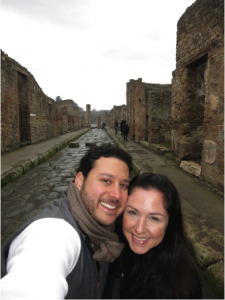 By car, it takes only a few minutes to get to Pompeii. And if you go in winter, like we did, you will find tranquility there among the millennia-old shops, theaters, homes, and alleyways. The January chill keeps the throngs of tourists at bay, so you have entire villas to yourself and empty streets to tease your imagination. Parts of Pompeii are so well preserved that you can imagine the prostitutes with their bleached-white tresses, luring customers to one of the many Pompeiian brothels (more than 30 have been excavated!). You can marvel at the perfect Roman roads that run in a solid grid and try to envision such a smooth path in the ravaged ground of the Roman Forum. You can stand without anyone to block your view and stare at the plaster cast of the chained dog, who guarded his master’s home until the bitter end. Finally, you can grasp with certainty the quality of life enjoyed by Pompeiian inhabitants. What really thrilled me was the thought of the public baths. The baths were nothing new to me, of course, but because of Andrea’s running narration, I recognized their significance. The baths gave even the poorest of Roman citizens a bit of luxury. They also kept people clean and limited the contraction of disease. Looking at the vaulted baths, I could not help but wonder if the human smells in ancient Rome might offend me less than those in some modern cities I’ve visited. I mean, there was sewage in the streets, so that was a real minus, but actual body odor was probably less offensive than you might think – for citizens, at least!
By car, it takes only a few minutes to get to Pompeii. And if you go in winter, like we did, you will find tranquility there among the millennia-old shops, theaters, homes, and alleyways. The January chill keeps the throngs of tourists at bay, so you have entire villas to yourself and empty streets to tease your imagination. Parts of Pompeii are so well preserved that you can imagine the prostitutes with their bleached-white tresses, luring customers to one of the many Pompeiian brothels (more than 30 have been excavated!). You can marvel at the perfect Roman roads that run in a solid grid and try to envision such a smooth path in the ravaged ground of the Roman Forum. You can stand without anyone to block your view and stare at the plaster cast of the chained dog, who guarded his master’s home until the bitter end. Finally, you can grasp with certainty the quality of life enjoyed by Pompeiian inhabitants. What really thrilled me was the thought of the public baths. The baths were nothing new to me, of course, but because of Andrea’s running narration, I recognized their significance. The baths gave even the poorest of Roman citizens a bit of luxury. They also kept people clean and limited the contraction of disease. Looking at the vaulted baths, I could not help but wonder if the human smells in ancient Rome might offend me less than those in some modern cities I’ve visited. I mean, there was sewage in the streets, so that was a real minus, but actual body odor was probably less offensive than you might think – for citizens, at least!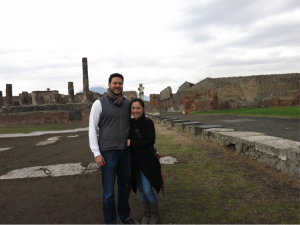 Andrea also pointed out different contraptions and daily devices in the city: the original fast food shops, the public toilets, the stepping stones in the streets to keep you out of flowing filth, etc. He opened my eyes to the many uses of urine, something I didn’t really want to know but that ultimately fascinated me. It turns out that they used urine to tan leather, to dye their hair, to soften wool, as a cleaning agent… it goes on and on! And, he even took us to the urine shop in ancient Pompeii. Although urine isn’t a chief attraction for any of us, we felt like we had an insider’s view into the city. Not to mention the fact that while other tourists poked their noses into maps to try to locate themselves and then plot a route, we literally coasted alone. Andrea knew it all. It was an incredible experience, but it was also efficient – not a moment wasted!
Andrea also pointed out different contraptions and daily devices in the city: the original fast food shops, the public toilets, the stepping stones in the streets to keep you out of flowing filth, etc. He opened my eyes to the many uses of urine, something I didn’t really want to know but that ultimately fascinated me. It turns out that they used urine to tan leather, to dye their hair, to soften wool, as a cleaning agent… it goes on and on! And, he even took us to the urine shop in ancient Pompeii. Although urine isn’t a chief attraction for any of us, we felt like we had an insider’s view into the city. Not to mention the fact that while other tourists poked their noses into maps to try to locate themselves and then plot a route, we literally coasted alone. Andrea knew it all. It was an incredible experience, but it was also efficient – not a moment wasted!
After Pompeii, we drove to Oplontis, simply one excavated home – but such a home. This was possibly the villa of Poppaea, Nero’s wife, whom he perfunctorily killed with a kick to the intestines. 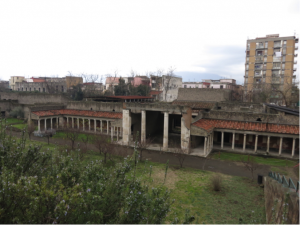 The villa was over 100,000 square feet in its day, perched directly above the sea. It clearly went through a series of owners, as many villas did in Pompeii, as well. However, the frescoes in the most recent additions to the home apparently bear a striking resemblance to those in the Domus Aurea, Nero’s extravagant, elaborate, insane home in Rome. Plus, ancient sources discuss the construction of a home for Poppaea near this site, roughly 10 years before the eruption of Vesuvius. Add all of that to the sprawling size and luxury of the villa, and you know someone of absurd wealth and importance lived here. Oplontis is a quick visit – just about a half-hour – and I hope you can see it with someone who has Andrea’s passion. He shows you how the lines of the villa always point to a gorgeous view and paints glorious pictures in your mind. The frescoes at Oplontis are bright and vivid because they are newly excavated, so those alone are worth a stop. The site is a work in progress; teams of archaeologists from the University of Texas at Austin are working diligently on their Oplontis Project.
The villa was over 100,000 square feet in its day, perched directly above the sea. It clearly went through a series of owners, as many villas did in Pompeii, as well. However, the frescoes in the most recent additions to the home apparently bear a striking resemblance to those in the Domus Aurea, Nero’s extravagant, elaborate, insane home in Rome. Plus, ancient sources discuss the construction of a home for Poppaea near this site, roughly 10 years before the eruption of Vesuvius. Add all of that to the sprawling size and luxury of the villa, and you know someone of absurd wealth and importance lived here. Oplontis is a quick visit – just about a half-hour – and I hope you can see it with someone who has Andrea’s passion. He shows you how the lines of the villa always point to a gorgeous view and paints glorious pictures in your mind. The frescoes at Oplontis are bright and vivid because they are newly excavated, so those alone are worth a stop. The site is a work in progress; teams of archaeologists from the University of Texas at Austin are working diligently on their Oplontis Project. 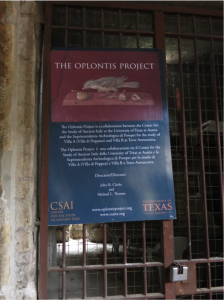 I expect they’ll do a good job of preserving what they find, but you should really come see it because everything we uncover fades with time. This is the newest excavation we have, so it’s a site at its peak.
I expect they’ll do a good job of preserving what they find, but you should really come see it because everything we uncover fades with time. This is the newest excavation we have, so it’s a site at its peak.
Our last stop of the day was at Herculaneum, a site that got a different type of material from the eruption of Vesuvius than Pompeii did. While pumice and large stones and ash buried Pompeii, viscous pyroclastic flows rushed into Herculaneum at lightning speed, filling it in completely and leading to much better preservation of organic materials. At Pompeii, archaeologists found pockets in the compacted volcanic material and filled them in with plaster to find evidence that humans died there during the event. However, no such cavities presented themselves at Herculaneum. No real sign of human life at all in Herculaneum…not until they excavated the arcades that once sat along the shoreline, holding places for boats. In those arcades, researchers found horrific scenes of humans who probably congregated along the beach because of the persistent earthquakes that accompanied the eruptions. During previous earthquakes, that type of maneuver had saved them – but not this time. The skeletons in the arcades are still visible as you approach Herculaneum from above (or at least resin replicas are). The shoreline has moved 500 meters or so away because of the volume of material deposited during the eruption, so you have to use your imagination to visualize the multileveled city towering over the beach. Inside Herculaneum, you’ll see carbonized ropes, beds, doors. You’ll get a peek at intact window glass. You’ll read signs prohibiting patrons from dumping manure into the streets. You’ll see ancient sewage systems. You’ll peer through a shop window to get a glimpse of an ancient iron – it turns out they didn’t like wrinkled togas any more than we would. It was pretty cool. Overall, Herculaneum is a small site. Even at its peak, it probably held 5,000 people. That makes it an easy visit. It should definitely be on your agenda.
As we traveled through Pompeii, Oplontis, and Herculaneum, I felt like the experience was a strange time warp, like I saw a prototype of our own world. No, these ancient Romans didn’t have electricity or motors, but they were far more advanced than our societies were before the Industrial Revolution. In Rome itself, you know that far more elaborate luxuries and technologies existed, but you can’t really see them because Rome itself was consistently inhabited. These sites were frozen in time. Every history buff in the world should see them. To prepare, you should listen to the lectures about Pompeii and Herculaneum. They help you approach the sites with focus and clarity, and they give you the background to ask meaningful questions along the way.
Now, a moment for our meals that day!
Lunch
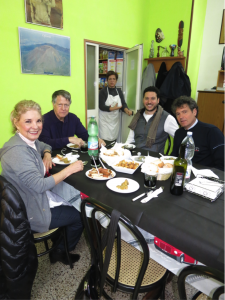 After the visit to Oplontis, Andrea took us for a surprise lunch at the most unassuming café in the world. There is no way on earth I would have known it existed. It’s a small room at the back of a tiny grocery store. There is only one table. There is also only one cook, and she’s a Sicilian grandma who knows everything there is to know about eggplant. She served us incredible food, all homemade. We started with a special bread that’s baked between layers of chopped prosciutto. Then, we moved onto marinated eggplant and the best eggplant/mozzarella pasta of my life. The pièce de resistance was a delicious eggplant parmigiana, and it wasn’t just like mamma used to make – it was what mamma still makes on a daily basis. We finished up with southern European strufoli, a dessert that sort of reminded me of corn pops but seemed to be a major hit with Italians, and creamy Neapolitan cake. All that, plus copious amounts of wine, and our lunch for five (paying for Andrea) was 60 euros, a far cry from the prices of home.
After the visit to Oplontis, Andrea took us for a surprise lunch at the most unassuming café in the world. There is no way on earth I would have known it existed. It’s a small room at the back of a tiny grocery store. There is only one table. There is also only one cook, and she’s a Sicilian grandma who knows everything there is to know about eggplant. She served us incredible food, all homemade. We started with a special bread that’s baked between layers of chopped prosciutto. Then, we moved onto marinated eggplant and the best eggplant/mozzarella pasta of my life. The pièce de resistance was a delicious eggplant parmigiana, and it wasn’t just like mamma used to make – it was what mamma still makes on a daily basis. We finished up with southern European strufoli, a dessert that sort of reminded me of corn pops but seemed to be a major hit with Italians, and creamy Neapolitan cake. All that, plus copious amounts of wine, and our lunch for five (paying for Andrea) was 60 euros, a far cry from the prices of home.
Dinner
 This was one of the great culinary experiences of my life. Andrea recommended a restaurant called Da Attilio, and every pizza lover on earth should go there. On the night we went, the place was packed with locals. We were the only tourists to be found, and the staff took a special liking to us. They seated us right away and treated us like royalty. We ordered two of their specialty pizzas – which are called sole because they resemble the sun. These masterpieces have their outsides folded over to make eight points, each of which oozes fresh ricotta cheese. Then, the centers burst with their toppings of either tomato and mozzarella or yellow tomatoes and porcini mushrooms. The pizzas were literally insane. I got the pappardelle with fresh porcini, but I could hardly restrain myself from Jamil’s and my dad’s pizzas. Those pizzas were absolutely addictive and enchanting. I am so glad I don’t live in Naples. I would have to eat there all the time. No amount of walking could burn that off.
This was one of the great culinary experiences of my life. Andrea recommended a restaurant called Da Attilio, and every pizza lover on earth should go there. On the night we went, the place was packed with locals. We were the only tourists to be found, and the staff took a special liking to us. They seated us right away and treated us like royalty. We ordered two of their specialty pizzas – which are called sole because they resemble the sun. These masterpieces have their outsides folded over to make eight points, each of which oozes fresh ricotta cheese. Then, the centers burst with their toppings of either tomato and mozzarella or yellow tomatoes and porcini mushrooms. The pizzas were literally insane. I got the pappardelle with fresh porcini, but I could hardly restrain myself from Jamil’s and my dad’s pizzas. Those pizzas were absolutely addictive and enchanting. I am so glad I don’t live in Naples. I would have to eat there all the time. No amount of walking could burn that off.
Naples Hotel: La Ciliegina Lifestyle Hotel
We’ve established that many tourists have a hard time with Naples, so it shouldn’t surprise you that five star hoteliers are reticent to invest in sweeping properties there. In my experience, four star hotels are often sketchy, especially if they’re big. I would much rather stay at a three star with a good reputation than a four star that earned its ratings 30 years ago. If you do stay at a four star, make sure you’ve read a ton of reviews on TripAdvisor and browsed reputable travel sites, like Frommer’s and Fodor’s. I know that sounds strange, but it’s the reality in Southern Europe. Believe me.
La Ciliegina is a four star that I researched repeatedly. It doesn’t have the seaside location that some other four stars do, but it received rave reviews for its cleanliness and service. At less than $130 per night, I figured our risks were low. Luckily, it was absolutely charming – with one major exception: they need to tone down the air freshener. We never could air it out. Yes, it’s a better smell than the smoke they were probably trying to mask, but it was intense, too intense for me. However, the service was perfect. The location was great. The rooftop sitting area was a bonus. I would stay there again, but I would call in advance and ask for a room with no air freshener!
